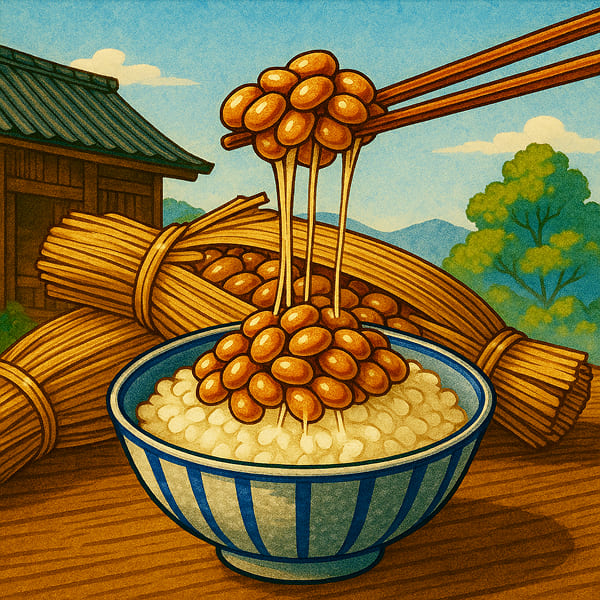Natto: Japan’s Traditional Fermented Superfood for Health and Culture

Contents
Slimy, sticky, and surprisingly nutritious—meet natto, Japan’s boldest breakfast food.
With its unmistakable stringy texture and pungent aroma, natto is a dish that often divides first-time tasters—but behind its unusual appearance lies one of Japan’s most powerful superfoods. Made from fermented soybeans and teeming with health-boosting bacteria, natto has been a staple of Japanese breakfasts for centuries.
Whether you find it fascinating or intimidating, natto offers more than just a unique culinary experience—it’s a symbol of Japan’s deep-rooted tradition in fermentation, and a daily reminder of how ancient wisdom meets modern health.
In this article, we explore the history, nutrition, and cultural significance of natto—and why this humble fermented bean continues to inspire both devotion and curiosity.
The Fascinating History and Origins of Natto
The exact origins of natto remain a subject of scholarly debate, but its history in Japan is undoubtedly ancient. While some theories point to the Warring States period (15th–16th centuries), when boiled soybeans wrapped in straw naturally fermented due to bacteria present in the straw, earlier evidence suggests natto may have existed long before.
The word “natto” appears in literary texts as early as the Heian period (8th–12th centuries), and since soybeans were already cultivated in the Jomon and Yayoi periods, it’s possible that fermented soy products were being made in prehistoric times. Though the details of its development are shrouded in mystery, natto gradually became an integral part of Japanese culinary tradition, cherished for its unique texture, flavor, and health benefits.
Nutritional Benefits and Health Power of Natto Fermentation
Natto is often regarded as a Japanese superfood thanks to its health-promoting fermentation process and rich nutrient profile. Key nutritional highlights include:
- Nattokinase enzyme
A powerful enzyme unique to natto, known to help dissolve blood clots and improve cardiovascular health by enhancing blood circulation. Although research is ongoing, nattokinase is gaining global attention as a natural heart health aid. - Vitamin K2 Vital for bone health, vitamin K2 in natto supports calcium absorption and strengthens bones, reducing the risk of osteoporosis.
- Plant-based protein
Natto offers a high-quality source of plant protein, essential for muscle repair and growth, especially valuable for vegetarians and vegans. - Probiotics
The fermentation bacteria in natto contribute to a healthy gut microbiome and support the immune system.
These combined benefits make natto an excellent addition to a balanced and health-conscious diet.
How to Enjoy Natto: Popular and Easy Ways to Eat This Sticky Superfood
While natto’s sticky texture and aroma can be challenging for newcomers, there are many delicious and approachable ways to enjoy it—even outside Japan. Here are some simple and popular ideas:
1. Natto Rice Bowl
A classic and easy way to enjoy natto:
Ingredients:
- 1 pack of natto
- 1 bowl of hot steamed rice
- 1 tsp soy sauce
- A small dab of Japanese mustard (karashi, optional)
- Chopped green onions (optional)
Instructions:
- Stir the natto well until it becomes sticky and stringy.
- Mix in the soy sauce and mustard.
- Pour over hot rice and top with green onions.
Tip: If you can’t find Japanese mustard, a tiny bit of Dijon mustard can work too.
2. Natto Toast
A fusion twist that’s surprisingly good for breakfast:
Ingredients:
- 1 slice of toast
- 1 pack of natto
- 1 tsp soy sauce or a dash of salt
- Optional toppings: shredded cheese, avocado, chopped tomato, or kimchi
Instructions:
- Mix the natto with soy sauce.
- Spread it on toast and add any toppings you like.
- Toast again briefly if adding cheese.
Great for those who like savory breakfasts!
3. Natto Temaki (Hand-Rolled Sushi)
Fun to assemble, even with friends or family:
Ingredients:
- Cooked sushi rice or regular rice
- Sheets of roasted seaweed (nori)
- 1 pack of natto
- Cucumber slices, avocado, or shiso leaves (optional)
Instructions:
- Cut seaweed into small squares.
- Place a spoonful of rice and natto in the center.
- Add optional fillings, roll it up, and enjoy like a taco.
No sushi mat needed—just roll by hand!
As global interest in fermented foods and plant-based eating grows, natto is slowly gaining recognition around the world as a uniquely nutritious and versatile ingredient. With a little creativity, you can easily make it part of your own meals—wherever you are.
Natto’s Role in Japanese Culture and Modern Life
Natto is more than a food—it embodies centuries of Japanese tradition, representing the wisdom of fermentation and harmony with nature. It continues to hold a significant place in modern Japanese diets, appreciated for both its cultural heritage and health benefits.
And today, natto is no longer limited to Japan. Thanks to growing global interest in gut-friendly foods and plant-based nutrition, natto is increasingly available in supermarkets and Asian grocery stores around the world—often in frozen or vacuum-sealed form.
So whether you're in Tokyo or Kyoto, or in cities across Asia, Europe, the Americas, or beyond—natto is increasingly within reach. Trying it is not just a culinary adventure—it’s a way to connect with a timeless food tradition that blends ancient knowledge with modern wellness.
Embracing natto means embracing a living piece of Japanese culture, wherever you are.